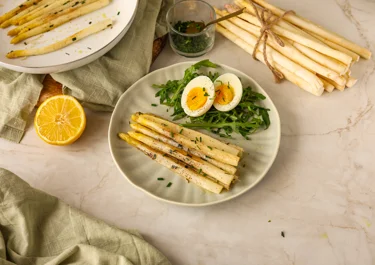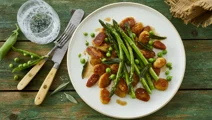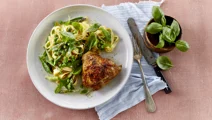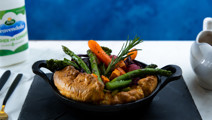Pan-fried white asparagus

Our pan-fried white asparagus shows that less really can be more. A few simple ingredients are all it takes to fully uncover its delicate flavour. And because this recipe is so simple, it makes a fantastic side dish that works with almost anything, or you can let it shine on its own as an appetiser and enjoy the beauty of seasonal produce.
Ingredients
|
White asparagus
|
2 kilos |
|---|---|
|
Butter
|
50 g |
|
Salt
|
|
|
Pepper
|
|
|
Fresh chives
|
30 g |
|
Lemon
|
½ |
Instructions
Recommended information
Serving suggestion
Choose the best white asparagus
Fresh white asparagus should be firm with smooth stalks and compact tips. The colour must be pure white, without any yellowing or greenish tint. Skip any that feel rubbery, have shrivelled ends, or show blemishes.
Peel and trim
Peeling white asparagus properly gives it a smooth texture and removes any fibrous, bitter bits. Lay the spears flat to prevent snapping. Using a vegetable peeler, start just below the tip and peel down to the base, applying more pressure for thicker spears to remove the more rigid outer layer. Peel at least 2–4 cm from the tip, or more if the spears are on the thicker side. Trim the ends to make them even and remove any woody parts.
Perfect the pan-frying
Melt the butter in a pan over medium heat until it foams lightly, which signals it is hot enough for frying. Arrange the asparagus in a single layer, leaving space between each spear for even cooking. Turn them often so they brown evenly and soften properly. If making a larger batch, cook in rounds rather than crowding the pan. Too many spears at once can lower the temperature and lead to uneven cooking.
FAQ: Questions about pan-fried white asparagus
White asparagus is a seasonal favourite, but how does it compare to the green variety, and how should you store it? Here are some answers to the most common questions on cooking this recipe.
How should I store white asparagus before cooking?
Keep white asparagus in the vegetable drawer of your fridge for 3–4 days. Wrap the spears in a damp cloth or paper towel to prevent them from drying out. For longer freshness, stand them upright in a jar or glass with a few centimetres of cold water and cover them loosely with a plastic bag. If they start to dry out, trim the ends slightly and soak them in cold water for about 30 minutes before cooking.
What is the difference between green and white asparagus?
White asparagus has a milder, slightly sweeter taste, while green ones have a more earthy and grassy flavour. The difference comes from how they are grown. White asparagus is covered with soil as it grows, blocking sunlight and preventing chlorophyll from forming, which keeps it pale. The green kind grows in the open and turns green from the sunlight. White ones also have a thicker, more fibrous outer layer that needs peeling before cooking, while green asparagus is usually tender enough to cook as is.
When is white asparagus in season?
The season for white asparagus depends on the region. In Europe, the peak season generally runs from April to June, though southern regions may start harvesting earlier due to milder winters. In Asia, they are available for longer, especially in China and Thailand, where it is grown year-round in some areas. In the United States, the season varies by state but generally falls between March and June.
Nutritional values
Nutritional value, per
735 Kcal
| Fibre | 54.3 gram fibers |
| Protein | 39.7 gram |
| Carbohydrates | 42.5 gram |
| Fat | 45.4 gram |
Enjoy the delicate flavours of pan-fried white asparagus
When spring rolls in and white asparagus finally lands at the markets, we know it is time to grab a bunch. And what better way to celebrate the vegetable than with a quick recipe for pan-fried white asparagus? In less than 20 minutes, you can bring out its delicate flavour with nothing more than a sizzle in butter.
A good sizzle in butter gives it a light golden edge and a nutty richness while the inside stays soft and silky. And honestly, you do not need much else. Just a sprinkle of salt and pepper, and it is good to go.
Fresh finish with lemon and chives
White asparagus is already delicious with just butter, salt, and pepper, but finishing it with lemon juice and chives takes it to new, extra-fresh heights.
A quick drizzle of lemon juice over the top coats each spear in a zesty, tangy layer that cuts through the richness of the butter. With their mild onion-like bite, chives introduce a gentle sharpness that feels pleasant next to earthy, delicate asparagus.
Serve with grilled meats or fish
Pan-fried white asparagus belongs at an outdoor feast, whether it is a picnic on a sunny afternoon or a barbecue where a breeze carries the scent of sizzling meat. It is buttery, a little sweet, and just the thing to serve alongside whatever is coming off the grill.
Grilled chicken, pork chops, or a tender lamb cutlet? They all work, especially when dipped into the buttery juices left on the plate. If fish is on the menu, salmon, sea bass, or trout are spot on, their flaky texture sitting nicely against the soft spears.
Of course, no outdoor spread feels complete without a fresh salad or something crunchy on the side. Try it with a simple Greek salad with feta, tomatoes, red onions, and olives or a crisp cucumber and radish salad with a light vinaigrette. For something heartier, roasted potatoes give a little extra comfort, while a hunk of warm bread is perfect for soaking up every last drop of butter.
A sunny outdoor spread calls for more asparagus. An asparagus salad with strawberries adds a fresh, fruity touch, while bacon-wrapped asparagus provides that smoky, crisp bite. And grilled asparagus? Well, that one speaks for itself, with a charred edge that makes it a barbecue staple.
Adjust the recipe to your liking
Simple adjustments to this recipe can sneak in more flavour without overcomplicating things. The butter does most of the work here, so why not give it some extra flavour? A touch of garlic adds a mellow savouriness that turns slightly sweet when sautéed, while a pinch of paprika offers a soft warmth.
Swapping the chives for another herb is also another way to switch things up. Tarragon leans into a light aniseed note, parsley brings a fresh and slightly peppery touch, and dill has a gentle, grassy sweetness.



&format=webp)




&format=webp)
